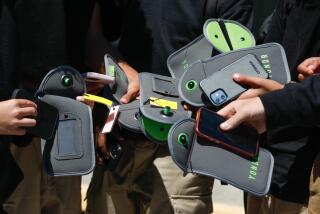Jump-Start the Urban Classroom Networks
- Share via
Just as cars aren’t particularly useful without roads and freeways, the same is true of an information highway without well-planned onramps and offramps. This is particularly evident in our schools.
While classroom connectivity increased from 6% to 14% between 1994 and 1996, most of these networks are low-speed analog connections, the computer equivalent of unpaved roads.
President Clinton advocates connecting all classrooms to the Internet, and this message has been heard by principals, administrators and school boards anxious to have their students log on. However, this presidential mandate has been largely unfunded, with private money/state projects and volunteer efforts substituting for systemic programs. Poor schools have suffered or been relegated to the slow lane or no lane.
The Snowe-Rockefeller amendment to the Telecommunications Act of 1996 corrected this deficiency by funding the necessary telecommunications infrastructure. But the Federal Communications Commission must still approve it.
This is critical if we’re going to solve the problem of getting all U.S. classrooms hooked up by 2000. The amendment’s plan to provide the largest hookup discounts for “have-not” schools will help jump-start connectivity. Today, 47% of schools with more than 70% of their students qualifying for federal lunch subsidies have no Internet access; only 22% of the schools where less than 11% qualify for free lunches are not hooked up. This gap must be closed.
Studies from pilot programs show higher test scores in English and math from Internet-enabled classrooms. More important, technology raises test scores more for underprivileged kids than for wealthy kids, more for kids who have interactive hands-on experience (e.g. the Internet) and more where schools invest in teacher training. Unfortunately, only 7% of urban schools mandate advanced telecommunications and networking skills training for teachers.
President Eisenhower’s conception and subsequent implementation of the U.S. highway system fostered our mobile society, creating industries and jobs. President Clinton’s vision of a nation of learners benefiting from the Internet offers similar return. Companies like Netscape and America OnLine are already providing jobs for American youth.
The amendment isn’t perfect, but it provides for much broader and systematic introduction of networking into our schools. It earmarks $2.25 billion annually for communications and networking equipment. The FCC commissioners should make the tough trade-offs and approve this highway construction project.






